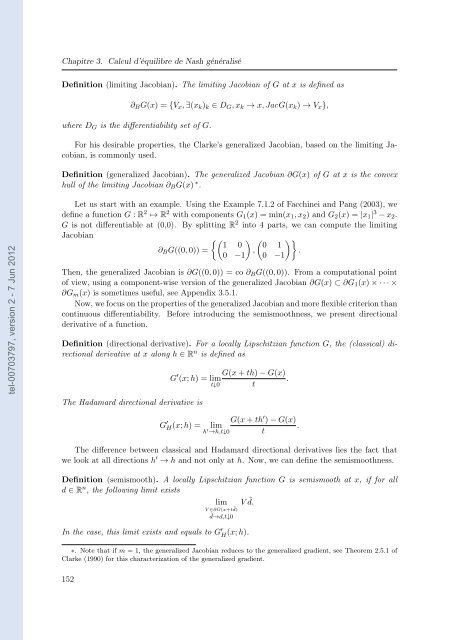Etude des marchés d'assurance non-vie à l'aide d'équilibres de ...
Etude des marchés d'assurance non-vie à l'aide d'équilibres de ...
Etude des marchés d'assurance non-vie à l'aide d'équilibres de ...
Create successful ePaper yourself
Turn your PDF publications into a flip-book with our unique Google optimized e-Paper software.
tel-00703797, version 2 - 7 Jun 2012<br />
Chapitre 3. Calcul d’équilibre <strong>de</strong> Nash généralisé<br />
Definition (limiting Jacobian). The limiting Jacobian of G at x is <strong>de</strong>fined as<br />
∂BG(x) = {Vx, ∃(xk)k ∈ DG, xk → x, JacG(xk) → Vx},<br />
where DG is the differentiability set of G.<br />
For his <strong><strong>de</strong>s</strong>irable properties, the Clarke’s generalized Jacobian, based on the limiting Jacobian,<br />
is commonly used.<br />
Definition (generalized Jacobian). The generalized Jacobian ∂G(x) of G at x is the convex<br />
hull of the limiting Jacobian ∂BG(x) ∗ .<br />
Let us start with an example. Using the Example 7.1.2 of Facchinei and Pang (2003), we<br />
<strong>de</strong>fine a function G : R 2 ↦→ R 2 with components G1(x) = min(x1, x2) and G2(x) = |x1| 3 − x2.<br />
G is not differentiable at (0,0). By splitting R 2 into 4 parts, we can compute the limiting<br />
Jacobian<br />
∂BG((0, 0)) =<br />
<br />
1 0 0 1<br />
,<br />
.<br />
0 −1 0 −1<br />
Then, the generalized Jacobian is ∂G((0, 0)) = co ∂BG((0, 0)). From a computational point<br />
of <strong>vie</strong>w, using a component-wise version of the generalized Jacobian ∂G(x) ⊂ ∂G1(x) × · · · ×<br />
∂Gm(x) is sometimes useful, see Appendix 3.5.1.<br />
Now, we focus on the properties of the generalized Jacobian and more flexible criterion than<br />
continuous differentiability. Before introducing the semismoothness, we present directional<br />
<strong>de</strong>rivative of a function.<br />
Definition (directional <strong>de</strong>rivative). For a locally Lipschitzian function G, the (classical) directional<br />
<strong>de</strong>rivative at x along h ∈ R n is <strong>de</strong>fined as<br />
G ′ (x; h) = lim<br />
t↓0<br />
The Hadamard directional <strong>de</strong>rivative is<br />
G(x + th) − G(x)<br />
.<br />
t<br />
G ′ H(x; h) = lim<br />
h ′ G(x + th<br />
→h,t↓0<br />
′ ) − G(x)<br />
.<br />
t<br />
The difference between classical and Hadamard directional <strong>de</strong>rivatives lies the fact that<br />
we look at all directions h ′ → h and not only at h. Now, we can <strong>de</strong>fine the semismoothness.<br />
Definition (semismooth). A locally Lipschitzian function G is semismooth at x, if for all<br />
d ∈ R n , the following limit exists<br />
lim<br />
V ∈∂G(x+t ˜ V<br />
d)<br />
˜d→d,t↓0<br />
˜ d.<br />
In the case, this limit exists and equals to G ′ H (x; h).<br />
∗. Note that if m = 1, the generalized Jacobian reduces to the generalized gradient, see Theorem 2.5.1 of<br />
Clarke (1990) for this characterization of the generalized gradient.<br />
152
















